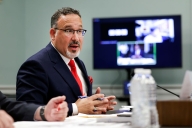You have /5 articles left.
Sign up for a free account or log in.
In college, I took a comparative politics class on settler colonialism. It focused on South Africa, Northern Ireland and Israel and the issues each faced. I don’t remember which book included it, but one of the books we read suggested that the way to win political control in a given area is to establish “facts on the ground.” The term was a shorthand for the physical geography of everyday life: streets, settlements, infrastructure. Facts on the ground become the background conditions that help determine the boundaries of political conflict.
Most of the content of that class is lost, but that idea stuck. It’s portable to other contexts. In the context of Tuesday’s conversation, ironically enough, the topic was diversity.
We were discussing the knee-jerk and often quite vigorous opposition that anything with a “diversity, equity and inclusion” label can generate. In hostile political climates, anything labeled “DEI” can become a lightning rod; some states are being quite blunt about it. The work needs to be done, and sometimes you just have to fight the fight. But sometimes it’s possible to go about creating facts on the ground that lead to a more diverse and accepting climate without triggering the folks who think that DEI is a threat.
For example, several years ago—before COVID—Brookdale met with the local public transportation agency and made the case to align the local bus schedule with the campus class schedule. The idea was to make it easier for students to take the bus to class.
To my mind, that was a diversity initiative. Students who don’t have cars are disproportionately low-income students and/or students of color; making the campus more accessible by bus benefited them the most. But it wasn’t exclusive to them; anyone could choose to take the bus. The presence of the option helped support campus diversity, but it didn’t set off any culture wars. It just quietly made the place more accessible. Over time, I noticed some employees with mobility or transportation challenges using that same bus. Why not?
Changing hiring processes can have a similar impact. I’ve mentioned before that replacing the solo judge in the last round with a small committee tended to result in both better and more diverse hires. But I never advertised it as such. It was just a way to ensure quality control. It worked; over time, the faculty grew more diverse seemingly without even trying. The facts on the ground shifted.
For students, widespread adoption of open educational resources had a similar effect to changing the bus schedule. Textbook costs are a higher barrier for lower-income students, but I’ve never heard a wealthy student complain that their books weren’t expensive enough. OER allows a more diverse student body to participate in class, but again, it doesn’t trigger those who are easily triggered.
I don’t think of any of these as subterfuge. Each one stands on its own merits. And sometimes a frank statement of values is necessary. But when political capital is finite and folks are easily triggered, creating facts on the ground can go a long way.
Wise and worldly readers, have you seen the “facts on the ground” strategy done well? If so, what did they do? As always, I can be reached at deandad (at) gmail (dot) com, on Twitter (@deandad) or on Mastodon (@deandad@masto.ai). Thanks!







